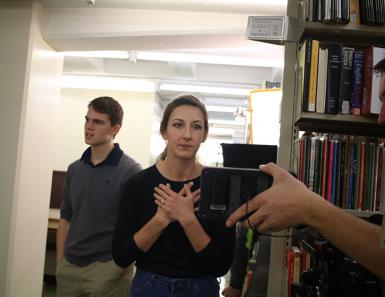Media School, Jacobs film collaboration features ballet dancers, original choreography
Ballet dancers glide through the aisles of the Herman B Wells Library with precision, while a team of Media School students, directed by Kasey Poracky, capture their dance for a short film collaboration between The Media School and the Jacobs School of Music.

“We wanted the audience to be able to experience dance differently,” Poracky said. “I think it can be made to be more immersive. You’re moving with them.”
The narrative short, Shift — expected to be released mid-semester — features 14 ballet dancers, including two feature performers, Julia Fleming and Julian Goodwin-Ferris. Goodwin-Ferris’ character is stuck in the rut of studying at the library, feeling unmotivated, but he catches a glimpse of Fleming’s character.
Fleming dances in the aisles of books, amidst the other dancers who act as Orwellian machines in the aisles. Fleming whisks Goodwin-Ferris away from his desk and into a dream sequence where they perform a pas de deux choregraphed by Sasha Janes, a former associate director at the Charlotte Ballet and current associate professor of ballet in Jacobs.
Poracky, a second-year M.S. student in design and production, and her team of Media School students collaborated with ballet students in the Jacobs School of Music to film the short, which showcases original choreography by Janes.
Poracky worked closely with Robert Mack, a sophomore ballet student, to bring his concept to life on a large scale.
Long before shooting began, Mack had the idea to create a film that would combine his two passions: filmmaking and ballet. Mack said he has always been a “film nerd” and was even on a few film sets as a kid. After switching from acting in middle school to ballet, he’d been searching for a chance to showcase the two.
“This is about coming together for a collaborative venture between Jacobs and The Media School to create something really cool,” Mack said.
The collaboration began about a year ago, when Mack approached Media School lecturer Craig Erpelding. Erpelding connected Mack with Poracky, who has an interest in ballet and was looking for an idea for her thesis project.
This was Poracky’s first time directing a shoot this large, so to ensure things went smoothly, she brought on AJ Salisbury, a cinema and media arts – studies and production senior, as her first assistant director.
Salisbury had served as a first A.D. before, but this was still a learning experience. Considering the high number of crew members and ensemble dancers, the film required a thorough shooting schedule, which Salisbury coordinated after discussions with Poracky.
The crew, led by Salisbury, met on the eighth floor of the Wells Library in late October to shoot the first sequence in the library aisles. The group reconvened the next day for another eight-hour shoot inside Studio 5 in the Radio-Television Building for the pas de deux.

The shot list included master shots and steady cam shots, and expanded to include four cameras shooting the dream sequence simultaneously. The team shot more than two terabytes of 4K footage.
The multitude of shots meant the dancers performed the choreography over and over, something Mack said was challenging, because a dance is never exactly the same twice.
The dancers were also used to performing once a night at 100 percent, so repeating the performance for multiple takes and angles was a learning curve, Mack said. The four cameras improved continuity, Salisbury said, allowing for more coverage of the same shots.
But the highly stylized movement and unusual performance space put the large crew to work.
Poracky scouted 13 large desks from the IU Surplus Store that the dancers used for the dream sequence. The desks had to be moved mid-shot, and sometimes the 13 vintage typewriters atop the desks had to move too.
Salisbury recounted the intricacy of shooting with that many moving pieces and performers. During the last shot, the heavy, vintage typewriter atop a desk had to move quickly out of frame without the camera seeing the stagehand running across the stage to grab it.
“You know the choreography, and you know the shots, but you can’t get in the middle of the action,” Salisbury said.
Creating work outside the classroom, or, in this case, in the library, pushes students more than in-class assignments do, Salisbury said. Producing on your own is a risk, but otherwise students will never learn how it actually happens.
“It could be really bad or it could be really good, but you won’t know until you try,” Salisbury said.
Poracky agreed, saying large, ambitious projects like this encourage tangible learning and take advantage of the freedom of an academic institution to experiment.
“What else are we doing if we’re not doing stuff like this?” she said.
Shift will begin post-production this month.

